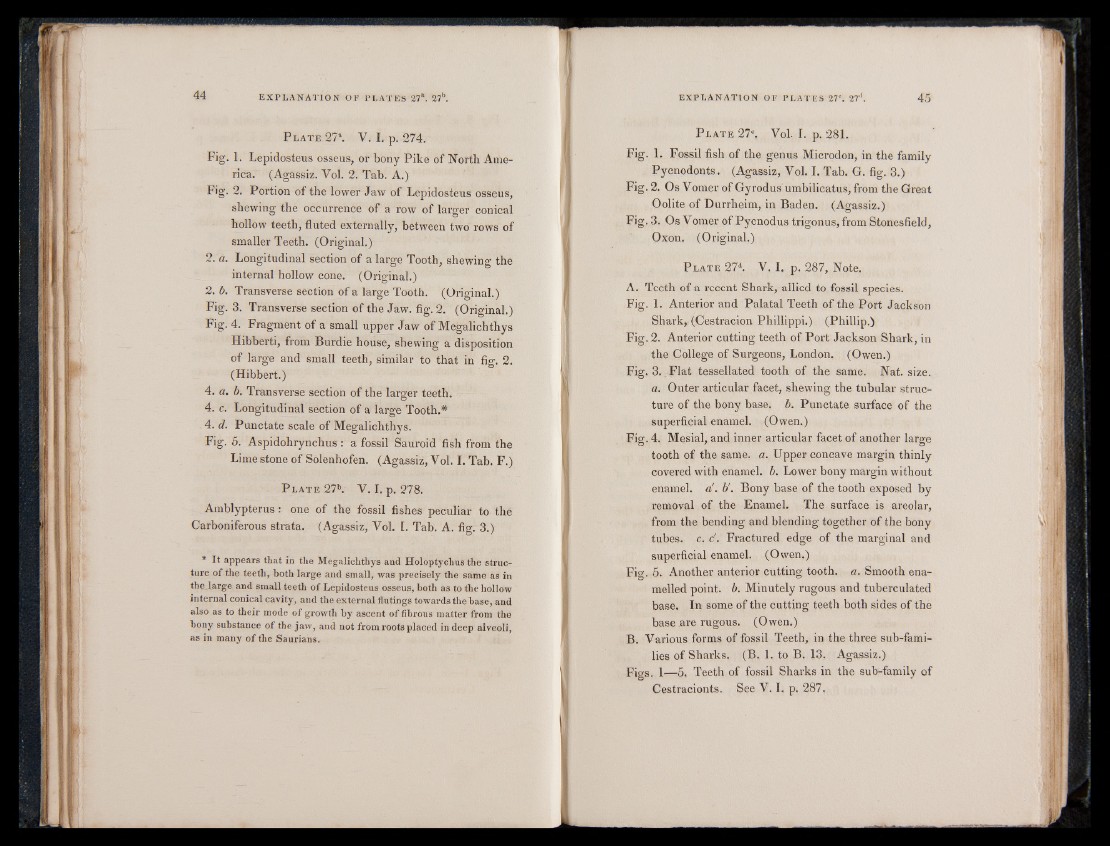
P late 27a. V. I. p. 274.
Fig. 1. Lepidosteus osseus, or bony Pike of North America.
(Agassiz. Vol. 2. Tab. A.)
Fig. 2. Portion of the lower Jaw of Lepidosteus osseus,
shewing the occurrence of a row of larger conical
hollow teeth, fluted externally, between two rows of
smaller Teeth. (Original.)
2. a. Longitudinal section of a large Tooth, shewing the
internal hollow cone. (Original.)
2. b. Transverse section of a large Tooth. (Original.)
Fig. 3. Transverse section of the Jaw. fig. 2. (Original.)
Fig. 4. Fragment of a small upper Jaw of Megalichthys
Hibberti, from Burdie house, shewing a disposition
of large and small teeth, similar to that in fig. 2.
(Hibbert.)
4. a. b. Transverse section of the larger teeth.
4. c. Longitudinal section of a large Tooth.*
4. d. Punctate scale of Megalichthys.
Fig. 5. Aspidohrynchus : a fossil Sauroid fish from the
Lime stone of Solenhofen. (Agassiz, Vol. I. Tab. F.)
P late 27». V. I. p. 278.
Amblypterus : one of the fossil fishes peculiar to the
Carboniferous strata. (Agassiz, Vol. I. Tab. A. fig. 3.)
* It appears that in the Megalichthys and Holoptychus the structure
of the teeth, both large and small, was precisely the same as in
the large and small teeth of Lepidosteus osseus, both as to the hollow
internal conical cavity, and the external flutings towards the hase, and
also as to their mode of growth by ascent of fibrous matter from the
bony substance of the jaw, and not from roots placed in deep alveoli,
as in many of the Saurians.
P late 27c. Vol. I. p. 281.
Fig. 1. Fossil fish of the genus Microdon, in the family
Pycnodonts. (Agassiz, Vol. I. Tab. G. fig. 3.)
Fig. 2. Os Vomer of Gyrodus umbilicatus, from the Great
Oolite of Durrheim, in Baden. (Agassiz.)
Fig. 3. Os Vomer of Pycnodus trigonus, from Stonesfield,
Oxon. (Original.)
P late 27d. V. I. p. 287, Note.
A. Teeth of a recent Shark, allied to fossil species.
Fig. 1. Anterior and Palatal Teeth of the Port Jackson
Shark, (Cestracion Phillippi.) (Phillip.)
Fig. 2. Anterior cutting teeth of Port Jackson Shark, in
the College of Surgeons, London. (Owen.)
Fig. 3 ..Flat tessellated tooth of the same. Nat. size.
a. Outer articular facet, shewing the tubular structure
of the bony base. b. Punctate surface of the
superficial enamel. (Owen.)
Fig. 4. Mesial, and inner articular facet of another large
tooth of the same. a. Upper concave margin thinly
covered with enamel, b. Lower bony margin without
enamel, a', b'. Bony base of the tooth exposed by
removal of the Enamel. The surface is areolar,
from the bending and blending together of the bony
tubes, c. c'. Fractured edge of the marginal and
superficial enamel. (Owen.)
Fig. 5. Another anterior cutting tooth, a. Smooth enamelled
point, b. Minutely rugous and tuberculated
base. In some of the cutting teeth both sides of the
base are rugous. (Owen.)
B. Various forms of fossil Teeth, in the three sub-families
of Sharks. (B. 1. to B. 13. Agassiz.)
pjgSi l—5, Teeth of fossil Sharks in the sub-family of
Cestracionts. See V. I, p. 287,